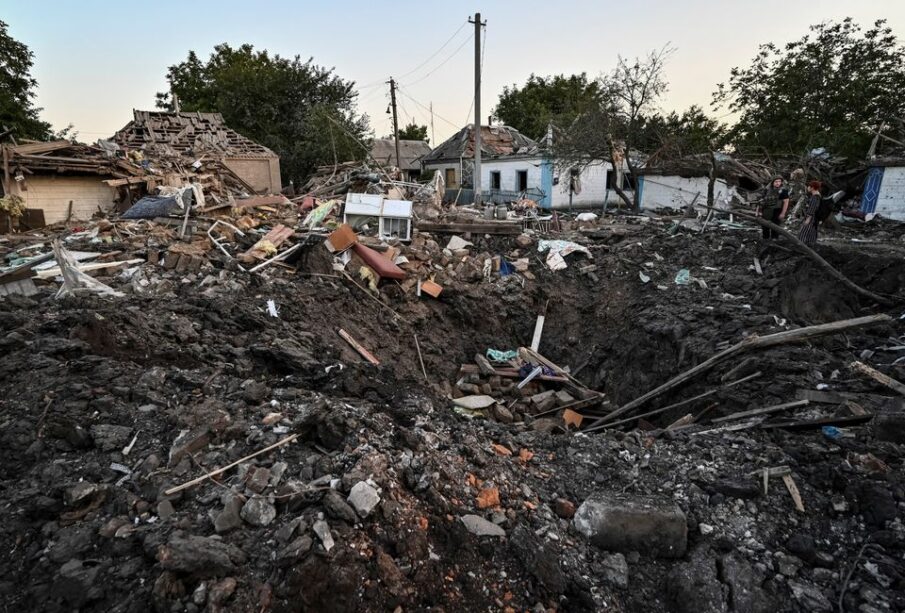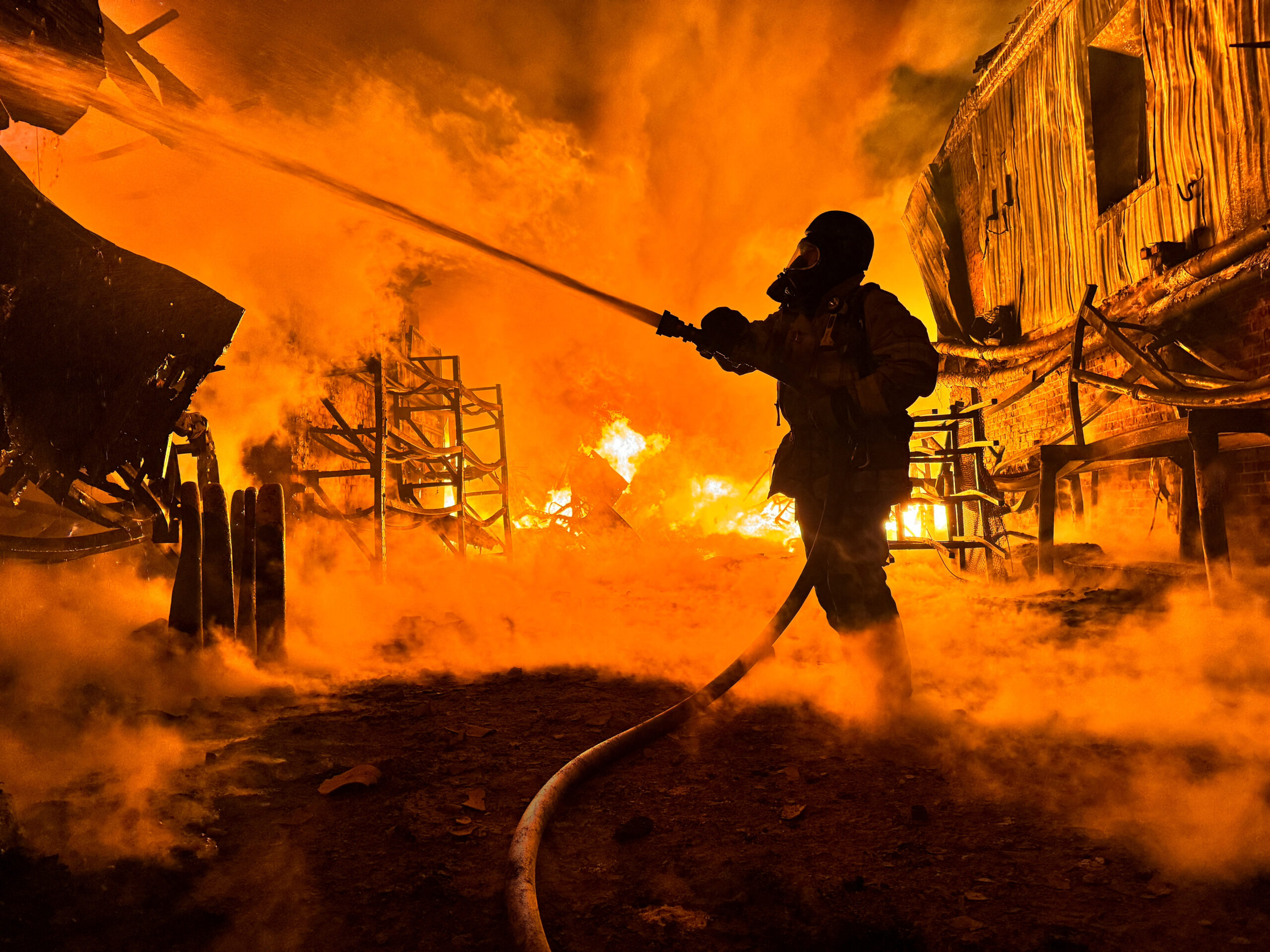Russian-held Ukrainian nuclear plant regains power link after cut amid nearby clashes
 People stand next to a residential house destroyed by a Russian military strike, as Russia's attack on Ukraine continues, in Chaplyne, Dnipropetrovsk region, Ukraine August 24, 2022. REUTERS/Dmytro Smolienko
People stand next to a residential house destroyed by a Russian military strike, as Russia's attack on Ukraine continues, in Chaplyne, Dnipropetrovsk region, Ukraine August 24, 2022. REUTERS/Dmytro SmolienkoThe last regular line supplying electricity to Ukraine’s Russian-held Zaporizhzhia nuclear power plant is working again after being cut earlier on Thursday, the United Nations said, an outage that underlined the potential peril posed by nearby fighting.
Ukrainian state nuclear company Energoatom said earlier that fires broke out in the ash pits of a coal power station near the Zaporizhzhia reactor complex, Europe’s largest such facility, disrupting lines linking the plant to Ukraine’s power grid.
“As a result, the station’s two working power units were disconnected from the network,” Energoatom said in a statement.
“Thus, the actions of the invaders caused a complete disconnection…, the first in the history of the plant.”
The last electricity supply to the plant was restored later in the day, the International Atomic Energy Agency, the Vienna-based U.N. nuclear watchdog, said in a statement.
“Ukraine told the IAEA that the ZNPP…at least twice lost connection to the power line during the day but that it was currently up again,” it said, adding that information on the direct cause of the outage was not immediately available.
Russia, which invaded Ukraine in February, captured the Zaporizhzhia plant in March and has controlled it since, although Ukrainian technicians from Energoatom still operate it.
Russia and Ukraine have accused each other of shelling the site, fuelling fears of the potential for a nuclear disaster.
Nuclear experts have warned of the risk of damage to the plant’s spent nuclear fuel pools or its reactors. Cuts in power needed to cool the pools to avoid a disastrous meltdown are another worry.
The United Nations is seeking access to the plant and has called for the area to be demilitarised. IAEA officials are “very, very close” to being able to visit Zaporizhzhia, agency Director-General Rafael Grossi said on Thursday.
As the war entered its seventh month, Russia said its forces had struck a railway station in eastern Ukraine the previous day, confirming an attack which Kyiv says also hit a residential area and killed 25 civilians as the nation marked its Independence Day.
The Russian Defence Ministry said an Iskander missile had hit a military train at Chaplyne station that had been set to deliver arms to Ukrainian forces on frontlines in the eastern Donbas region.
Ukrainian officials said 21 people were killed when the railway station was hit and five train carriages went up in flames, and a boy died when a missile struck his home in the vicinity. The death toll rose to 25 on Thursday after three more bodies were retrieved from rubble, they said.
The Russian ministry said 200 Ukrainian military personnel had died in the attack. Moscow denies targeting civilians and has said rail infrastructure is a legitimate target since it serves to supply Ukraine with Western weapons.
Reuters was unable to independently verify the reports.
But the United Nations humanitarian coordinator for Ukraine said she was shocked by the attack, and U.S. Secretary of State Antony Blinken said it “fits a pattern of atrocities”.
NUCLEAR PLANT RISK
The fighting in the area around the Zaporizhzhia nuclear power station has been a source of concern for weeks.
The sprawling complex supplied more than 20% of Ukraine’s electricity needs and its loss would pile new strain on the government.
Energoatom said earlier the plant’s security systems were working normally and work was under way to reconnect one of the reactor blocks to the grid, it said. The power plant has six reactors in total.
Russia’s Novosti news agency reported safety systems at Zaporizhzhia were activated on Thursday after power cuts were reported across swathes of Russian-controlled territory.
Ukraine’s energy minister said IAEA officials could travel to the Zaporizhzhia plant in the coming days.
“A visit is planned,” German Galushchenko told Reuters in Kyiv. “Definitely no later than the beginning of September.”
WAR OF ATTRITION
Russia’s ground campaign has stalled in recent months after its troops were repelled from the capital Kyiv in the early weeks of the invasion, which kicked off on Feb. 24.
Russian forces control a swathe of territory in the south along Ukraine’s Black Sea and Sea of Azov coasts, while the conflict has settled into a war of attrition in the Donbas.
In its daily briefing, Russia’s Defence Ministry said it had destroyed eight Ukrainian warplanes in strikes at air bases in Ukraine’s Poltava and Dnipropetrovsk regions. That would be one of the heaviest losses for Ukraine’s air force in recent weeks.
Kyiv has repeatedly called for more, high-grade Western military hardware it says it needs to repel Russian attacks.
Ukrainian President Volodymyr Zelenskiy spoke on Thursday by phone with U.S. President Joe Biden, who reiterated U.S. support for Ukraine against Russia, the White House said.
“We discussed Ukraine’s further steps on our path to the victory over the aggressor and importance of holding Russia accountable for war crimes,” Zelenskiy said in a tweet.
In a move that might bolster Western estimates of heavy Russian losses during the war, President Vladimir Putin signed a decree on Thursday increasing the size of Russia’s armed forces to 2.04 million from 1.9 million.
The Kremlin says its aim is to “denazify” and demilitarise Ukraine and remove perceived security threats to Russia.
Its stance has been dismissed by Ukraine and the West as a baseless pretext for an war of conquest that has killed thousands of civilians, displaced millions and left cities in ruins. It has also shaken the global economy, creating shortages of essential foods and sending energy prices soaring.
SOURCE: REUTERS











